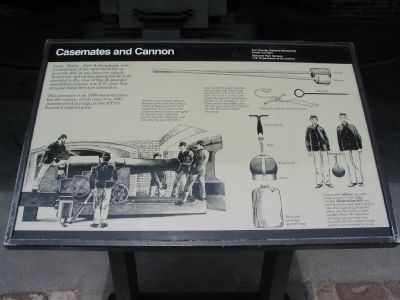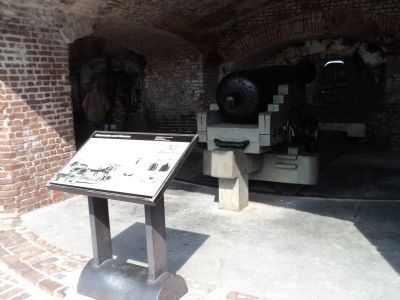Charleston in Charleston County, South Carolina — The American South (South Atlantic)
Casemates and Cannon
This casemate is an 1870 reconstruction, but the cannon, which rests on a 1961 reconstruction carriage, is one of Fort Sumter's original guns.
Artillery crews drilled daily to increase speed and skill using a variety of specialized tools and implements. Cannoneers were assigned specific duties: sponging the barrel, ramming home powder and shot, sighting, and adjusting the gun's direction.
Crew members would puncture the cartridge bag (containing gunpowder) with a vent pick, place the friction primer, and attach the lanyard, which was yanked on the command "fire." Tasks varied depending on the type of gun and the projectile selected for a given target and range.
Erected by Fort Sumter National Monument, South Carolina - National Park Service - U.S. Department of the Interior.
Topics. This historical marker is listed in this topic list: War, US Civil. A significant historical year for this entry is 1870.
Location. 32° 45.15′ N, 79° 52.51′ W. Marker is in Charleston, South Carolina , in Charleston County. Marker is located at Fort Sumter National Monument and only reached by boat. See links below for more information about access to the site. Touch for map. Marker is in this post office area: Charleston SC 29412, United States of America. Touch for directions.
Other nearby markers. At least 8 other markers are within walking distance of this marker. 42-Pounder, Banded and Rifled (a few steps from this marker); Powder Magazine (a few steps from this marker); Mining Casemate (a few steps from this marker); Holding the Fort (within shouting distance of this marker); Gorge Wall (within shouting distance of this marker); Battery Huger (within shouting distance of this marker); Fort Sumter 1861-65 (within shouting distance of this marker); The Garrison Defending Fort Sumter (within shouting distance of this marker). Touch for a list and map of all markers in Charleston.
More about this marker. On the left side of the marker is a drawing depicting a crew drilling with the cannon. On the right are drawings of the implements used with the cannon - sponge, rammer, vent pick, lanyard hooked to friction primer, fuse wrench, and fuse. The drawings also show a fixed shell, sabot, and detached cartridge (powder bag). The drawing on the lower right shows two soldiers carrying a shell. Cannoneers use shell longs to carry a ball. A fuse wrench was used to screw a fuse into a shell or case shot (exploding projectile) which was fixed onto a sabot (wooden base). The detached cartridge (powder bag) was rammed into the cannon barrel, and the shot rammed in on top.
Credits. This page was last revised on October 23, 2020. It was originally submitted on May 19, 2010, by Craig Swain of Leesburg, Virginia. This page has been viewed 1,055 times since then and 33 times this year. Photos: 1. submitted on May 19, 2010, by Craig Swain of Leesburg, Virginia. 2. submitted on August 4, 2013, by Bill Coughlin of Woodland Park, New Jersey. 3, 4. submitted on May 19, 2010, by Craig Swain of Leesburg, Virginia.



